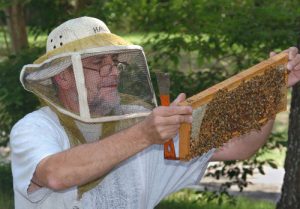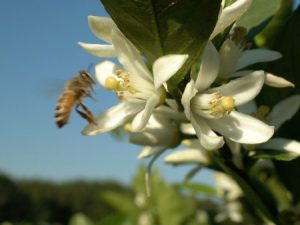Did you know that each honeybee produces a mere teaspoon of honey during its lifetime, but they are still one of the major contributors to our food resources? Were you aware that 80% of the food consumed in America is directly or indirectly pollinated by bees? A good example is California, who is globally the largest commercially producing almond grower. Every single almond has come to fruition as a result of the pollination of almond blossoms by honeybees. The knowledge of these facts should cause concern considering the threats to our honeybee populations.
Honeybees were brought to America by the early white European settlers. These bees are known globally as European common or Western bees. According to the Los Angeles County Beekeepers, “The creation of the United States can be found in the footsteps of the honeybee.”.
Honeybees are fascinating creatures which achieve four stages of life. It is classified as a complete metamorphosis consisting of the egg, larva, pupa and adult stages. The honeybee colony contains workers (non-reproductive females), the male “caste”, which are drones, and the mother of the colony, which is the queen. Like in Great Britain, it is all about the Queen. Under the usual conditions, the queen is the sole reproductive colony female, producing as many as 1,500 eggs daily. The queen possesses the queen mandibular pheromone which alerts the colony to sense their queen’s presence. The colony itself is a biological unit called a superorganism. In this respect, the reproduction of honeybees results in the forming of a new colony through swarming during the spring and early summer months.
According to “European Honeybee Apis mellifera Linnacus and Subspecies (Insecta: Hymenoptera: Apidae)”, in the colony, unfertilized eggs develop into drones (males) and fertilized eggs develop into females. Female larvae that are fed pollen, nectar and brood food become adult workers. Female larvae fed a rich diet of royal jelly, pollen and nectar develop into queens. The process of metamorphosis in honeybees is different for each caste, with drones having the longest developmental time at 24 days, followed by workers at 21 days and queens at 15 or 16 days.
According to Dr. Jaime Ellis, who directs honeybee research at the University of Florida, in his recent podcast “Buzz on Florida Honeybees”, there are 5,000 registered beekeepers in Florida alone. These bees are trucked all over the United States. With 20,000 species on the planet, 320 of those bee types reside in Florida.
The three stressors of bees are: nutrition, queen quality and Varroa. Therefore, the primary issues in beekeeping are managing nutrition, managing queens, transporting bees and managing Varroa mites.
Registered beekeeper, Robbie Bell, who is an associate of Dr. Jaime Ellis, states that Varroa is the biggest problem for modern-day beekeepers. These huge parasites transmit pathogens fatal to honeybees. Varroa mites burrow into the honeybees and suck blood from the adult bees, resulting in deformed baby bees. At this point, most of the worker bees disappear, leaving a queen, food and several nurse bees to care for the surviving bees and their queen. Add to this the fact that we lose habitat daily to urbanization, you can begin to understand the issues facing today’s beekeepers.
Bell states that another issue facing honeybees are neonicotinoids which are new pesticides that are “playing havoc with this industry”. He states that, “these new pesticides which are in use to help combat citrus greening, are messing up the bee’s guts so they cannot process their food”. Bell goes on to say that many beekeepers are wary of placing their bees in groves where neonicotinoids are in use. It is for this reason that orange blossom honey, which was once a roadside staple, is now difficult to find. It is also important that beekeepers prevent colony collapse disorder by maintaining good apiary hygiene through Best Management Practices (BMP’s).
Even despite these issues, beekeeper Robbie Bell is always booked up for his pollination services. Just like the harvesters, pollinator services follow the crops. Back in the 1990’s, Robbie Bell pollinated the Cape Cod cranberry bogs of Ocean Spray. He did watermelons in Florida, strawberries and cantaloupes. Then came the California almonds. These almonds are 100% dependent on bees and are required to have four hives per acre in order to obtain crop insurance. California is the only place in North America where almonds are cultivated for commercial distribution. 90% of these almonds are sent to Asia, where they would have to literally be hand-pollinated were it not for the availability of almonds from California. After about a month in California, Bell returns his eight semi-trucks full of bees to Florida, where he turns his attention to melons, cantaloupes, etc. Bell says Florida beekeepers sent out 560 truckloads of bees in January to California. He says, “The driving force in honeybee industries are California almonds.”.
There is a down-side to the shipping of bees, however. They are a fragile insect being hauled over the roads for long periods of time. Therefore, some are lost from the transportations process.
Bell states that there have been good and bad years for the beekeepers. The mid-1990’s saw a decline in natural pollinators, due in part to habitat loss. He then began to receive calls from watermelon growers for pollination services.
An interesting aspect of beekeeping is the necessity for, and use of, the invasive Brazilian pepper as a pollination source. Not only is this plant necessary, it is the most important honey source in Florida, nutritionally speaking, as it feeds the bees through the winter.
Registered beekeeper Bell began to ply his trade with his grandfather’s hives. By 1980, he had 300 hives. Bell spent eight years as a Publix meat cutter but has provided pollination services for 39 years. His family has been involved as well, with his wife, Melony, travelling with daughters Ashley and Whitnie in the early years, to visit their dad as he provided pollination services for alfalfa and clover farmers in North and South Dakota. Bell’s wife, Melony, who is a member of Florida’s House of Representatives, has a bill going forward in support of a new honeybee license plate with the proceeds going to honeybee research. This research will benefit scientists like Dr. Jaime Ellis and other University of Florida IFAS researchers, to address the issues facing today’s beekeepers.
This blog post was written by Master Gardener Volunteer Debra Howell here under supervision of the Master Gardener Volunteer Coordinator and Residential Horticulture Agent Anne Yasalonis.
For more information, contact UF/IFAS Extension Polk County at (863) 519-1041 or visit us online at http://sfyl.ifas.ufl.edu/polk. The Plant Clinic is open Monday-Friday, 9:00 am-4:00 pm to answer your gardening and landscaping questions. Visit us in person, give us a call, or email us at polkmg@ifas.ufl.edu.
If you are not in Polk County, Contact your local UF/IFAS Extension Master Gardener Volunteer Plant Clinic.
The Florida Master Gardener Volunteer Program is a volunteer-driven program that benefits UF/IFAS Extension and the citizens of Florida. The program extends the vision of the University of Florida/Institute of Food and Agricultural Sciences, all the while protecting and sustaining natural resources and environmental systems, enhancing the development of human resources, and improving the quality of human life through the development of knowledge in agricultural, human and natural resources and making that knowledge accessible.
An Equal Opportunity Institution.
 0
0
